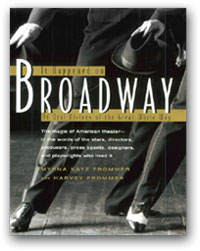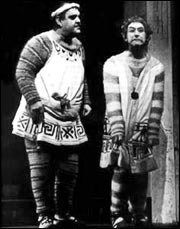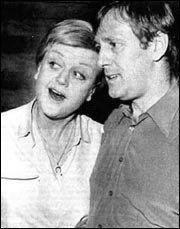

 |
|
| Buy This Book |
Tony Walton: Zero Mostel and Jack Gilford were cast for A Funny Thing
Happened on the Way to the Forum. George Abbot had become the director, and
I was doing sets and costumes. We were floundering out of town, an absolute
disaster. When we opened in Washington, George Abbot gave an interview saying,
"I think we could save the sucker if we threw out all the songs."
Steve Sondheim made a big pitch to Hal Prince to bring Jerry Robbins back in. Robbins had been the original director but had backed out before rehearsals because he had gigantic success with his Ballets U.S.A. at the Spoleto Festival in Italy and needed to shepherd its company on the resulting world tour. Hal phoned Zero to ask him whether he would be prepared to work with Jerry Robbins.
"Are you asking me to eat with him?"
"I'm just asking you to work with him."
"Of course I'll work with him," Zero said. "We of the left do not blacklist."
 |
|
| Photofest |
The original opening number had been light, lovely soft-shoe called "Love Is in the Air." George Abbot was very keen on it because it was something you could hum and he felt the opening number should be something you could hum. But Robbins said the opening number has to let the audience know what it's in for. The existing song led them to expect something elegant and light whereas the show is actually broad low comedy and slapstick.
So Jerry nudged Steve Sondheim into writing "Comedy Tonight." Some of the lyrics were lines virtually right out of Jerry Robbins' mouth, Steve wrote it in sort of a white heat. The song went into the show on the first preview in New York, in the spring of 1962. It literally changed Forum into an overnight smash.
But when Jerry first came in, we were all terrified. He was already a daunting figure. This was - after all - well after West Side Story. We stood on the stage of the National Theater in Washington. Jerry Robbins ran the gauntlet, shaking everyone's hands. When he finally got to Zero, everyone held their breath. The tension was palpable.
Then Zero boomed out, "Hiya, loose lips."
And everyone burst out laughing - including Jerry.
Martin Richards: Mary Lea Johnson, Bobby Fryer, and his partner, Jimmy
Cresson, formed a company called the Producers Circle. Hugh Wheeler and Stephen
Sondheim came to audition the music and tell us the story of Sweeney
Todd. Mary Lea flipped out over it.
Len Cariou: I got the script for Sweeney Todd when I was back home in Winnipeg. During my lunch hour, I began reading it, and I came to the lyric "There's a hole in the world like a great black pit / And it's filled with people who are filled with shit."
What the hell is this? I wondered. Who ever heard such lyrics?
Over the weekend, when there were no distractions, I read the script again. I thought, This is a bizarre a subject matter as one can imagine: a mad barber who kills his clients and has them made into meat pies. But if Stephen writes a very romantic score to such a subject, it will work like gangbusters.
The script was in my head way before rehearsals began. I realized that it was an extraordinary opportunity for me. The character is so interesting, so tormented, the role so demanding as an actor and as a singer. It's my favorite, hands-down.
Martin Richards: Hal always does a run-through for friends in the business, chorus kids, gypsies, to get a reaction. Usually they're a positive audience. But at the run-through for Sweeney Todd, it all went down the toilet.
Stephen Sondheim came over to me. "Where's the show? Where's the show? What are we going to do?
Sondheim doesn't speak to everybody, I was honored.
We got together in his townhouse. There was a big controversy. People said to each other, "I didn't want to do the show in the first place," this and that.
Stephen and Hal had words. Finally Hal said, "If everyone stays out of my hair for forty-eight hours and leaves me alone, I will restage the whole thing." He decided to place the show in the middle of the Industrial Revolution, when machines were dwarfing the whole world. That's when everything came together.
Quite often Hal starts by getting a whole picture and saying, "This is the way I want the set to look." For Sweeney Todd he wanted us to buy a steel factory. We had to buy the whole thing in order to get the pieces that we needed. It cost a fortune.
We used as much Grand Guignol - the horror theater of France - as the audience could take. We had these special trick razors that made blood come out of the razors. One time in previews the blood ran down the shirts. There was a very heavy reaction. So we cut it down to a little drip, just the suggestion.
 |
|
| Photofest |
Martin Richards: The people who came to previews said, "How brilliant, how brilliant!" But the theater-party ladies did not want to buy tickets, and when they did they walked out in droves. One lady hit me with a shopping bag right in the lobby of the theater, yelling, "What kind of thing is this, to show people eating people for a musical?"
Uh-oh, I thought, maybe we're in trouble. But once the reviews came out you couldn't get a ticket. Sweeney Todd was like chic. All those people who had been turned off to the show were now lining up for tickets.
Still, none of us knew what we had. Like Oklahoma!, Sweeney Todd has gone down as a landmark musical.
Len Cariou: There was a scene in A Little Night Music that called
for me to do a kind of eleventh-hour song, but Stephen Sondheim was having a problem writing it. We rehearsed everything around it until there was nothing left to rehearse, and he still hadn't written the song.
Hal Prince, Glynis Johns, Hugh Wheeler, and I were in the rehearsal room working on the missing song. I said, "I don't think my character should say this because of the changes we've made. We have to find some other language." They all agreed. We improvised a bit, changed the scene into something new, and called Stephen down to see it.
"Thanks very much," he said. "I think that is going to help me. I think I'm finally going to get my song."
About three days later he came in. "I have the new song," he said, sitting down at the piano. I was licking my chops. But Stephen looked up at me and said, "Sorry, Len. Because of all the changes, it isn't your song anymore. It's Desiree's."
And he went on to play, "Isn't it rich? Aren't we a pair..."
I just stood there, :Send in the clowns" was the song Sondheim was supposed to write for me.
Glynis Johns had never sung before in her life. She had no vocal training. But she had a quality in her voice, and Stephen tailored it for her, very simple, very short phrases. I still think her version of "Send in the Clowns" is the best ever.
Ted Chapin: Sondheim was writing songs for Follies even while rehearsals were going on. As production assistant, I was kept busy taking sheet music to him and bringing them to the music copyists. We were in Boston when they decided to expand "Can That Boy Foxtrot?" because Yvonne De Carlo, playing the part of a faded movie queen, was going to sing it. The song ended up being longer but not better. It had to be changed. "What is this four-note range that Yvonne has again?" Steve asked. And off he went. A couple days later he handed me a lyric page: "I'm Still Here."
Fourteen changes were made to the lyrics of that song. They were as subtle as "I got through three commercials, and I'm here" changed to "I got through five commercials" because "through three" is hard to sing. A couple days later he changed it to "I'm almost through my memoirs, and I'm here."
Len Cariou: I was with Stephen in his apartment, and he played "The Ballad of Sweeney Todd." He said, "Do you know the 'Mass of the Dead' in the Catholic Church?"
I said, "Yes, I'm Catholic."
He played the first line of the mass, and then the melody to "Attend the tale of Sweeney Todd..."
It was the notes of the mass in reverse. That was a little conceit of Stephen's. I'm sure nobody knows half of them. He has his own private humor.
Purchase this book:It Happened on Broadway:
An Oral History of the Great White Way
by Harvey and Myrna Katz Frommer
Copyright © 1998 by Harvey Frommer and Myrna Katz Frommer.
All Rights Reserved. A Harcourt Brace
& Company Book
“Assassins is about how society interprets the American Dream, marginalizes outsiders and rewrites and sanitizes its collective history. "Something Just Broke" is a major distraction and plays like an afterthought, shoe horned simply to appease. The song breaks the dramatic fluidity and obstructs the overall pacing and climactic arc which derails the very intent and momentum that makes this work so compelling...”
- Mark Bakalor
“I found [the Sondheim Celebration's Company] to be completely delightful. Almost all of the numbers excited and energized me, and most of the scenes were about as pitch-perfect as you can get. I just sat there with a big smile on my face the whole show.
Which is not to say that it is perfect...”
- popcornonmyknees
Explore the rest of the Finishing the Chat Community Forum
|
|
CD: $13.99
DVD: $25.49
VHS: $19.98
|
|
Browse additional merchandise...